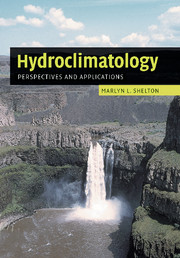Book contents
- Frontmatter
- Contents
- Preface
- 1 The realm of hydroclimatology
- 2 The climate system and the hydrologic cycle
- 3 Measuring hydroclimate atmospheric components
- 4 Measuring hydroclimate terrestrial components
- 5 Remote sensing and hydroclimate data
- 6 The runoff process and streamflow
- 7 Hydroclimate spatial variations
- 8 Hydroclimate temporal variations
- 9 Floods: the hydroclimatic extreme of excessive moisture
- 10 Drought: the hydroclimatic extreme of deficient moisture
- References
- Index
1 - The realm of hydroclimatology
Published online by Cambridge University Press: 06 July 2010
- Frontmatter
- Contents
- Preface
- 1 The realm of hydroclimatology
- 2 The climate system and the hydrologic cycle
- 3 Measuring hydroclimate atmospheric components
- 4 Measuring hydroclimate terrestrial components
- 5 Remote sensing and hydroclimate data
- 6 The runoff process and streamflow
- 7 Hydroclimate spatial variations
- 8 Hydroclimate temporal variations
- 9 Floods: the hydroclimatic extreme of excessive moisture
- 10 Drought: the hydroclimatic extreme of deficient moisture
- References
- Index
Summary
Water as a unifying concept
Water is an essential resource for humans and for natural ecosystems. Satellite images of the Earth show convincing evidence of an abundance of water on the planet. Unfortunately, only a small percentage of the total water volume is available as freshwater suitable for humans and many natural ecosystems. The relatively small volume of freshwater is further constrained by an uneven distribution over the globe that is paradoxical to the image of Earth as a water planet. Approximately one-third of the world's population lives in countries where the freshwater supply is less than the recommended per capita minimum, and 70 percent of all freshwater withdrawals from lakes, rivers, and groundwater is for crop irrigation to provide food (Entekhabi et al., 1999). Such disparities in water supply and water demand require understanding the underlying physical processes that account for spatial and temporal differences in the occurrence and magnitude of the water supply.
The physical characteristics of water are significant in accounting for how the freshwater supply is sustained. A combination of natural processes collectively recognized as the hydrologic cycle provides the mechanism for the natural redistribution of water among the land, oceans, and atmosphere. Water is the only chemical compound that occurs in natural conditions as a solid, liquid, and gas. The transformation of water from one physical state, or phase, to another is a critical factor in the transportability of water.
- Type
- Chapter
- Information
- HydroclimatologyPerspectives and Applications, pp. 1 - 23Publisher: Cambridge University PressPrint publication year: 2008



